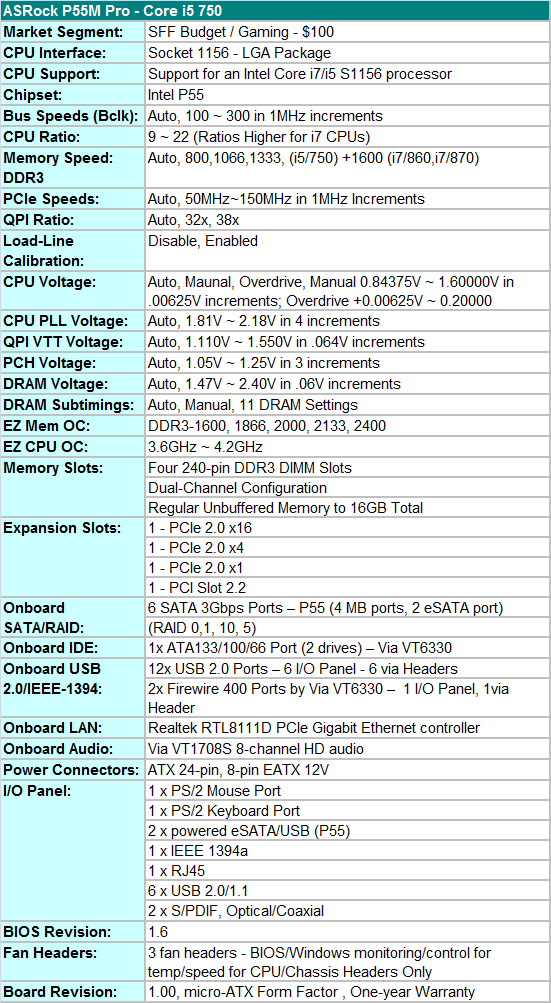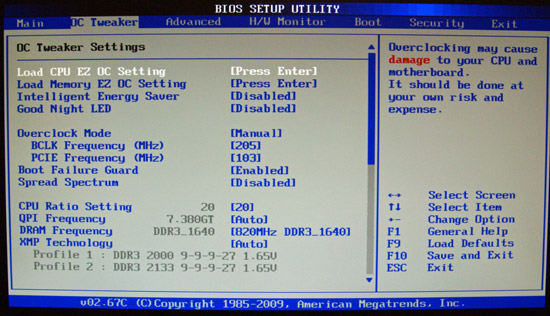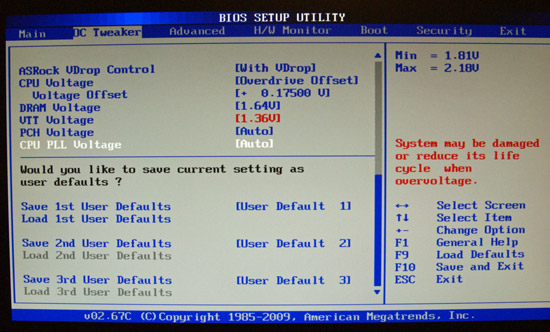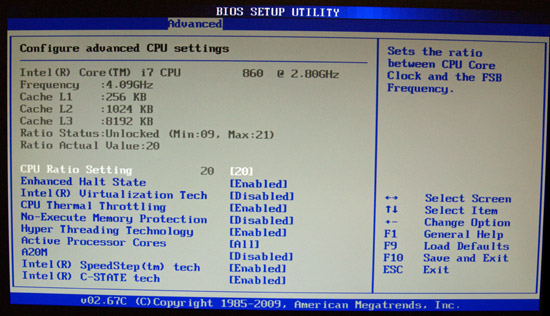Budget Micro-ATX P55 Faceoff: Gigabyte GA-P55M-UD2 and ASRock P55M Pro
by Gary Key on October 5, 2009 12:30 PM EST- Posted in
- Motherboards
Next up is ASRock’s P55M Pro. You can purchase this board for around $100.
ASRock P55M Pro Feature Set

ASRock includes a full featured set of components like the Via VT1708S HD audio codec, Realtek RTL8111D Gigabit LAN controller, Via VT6330 IDE/IEEE 1394a combo chipset, powered eSATA/USB ports on the I/O panel, and full support for the Core i7/i5 S1156 processor series.
ASRock also includes a limited accessories bundle. You get the standard rear I/O panel cover along with 1 x IDE cable, 1 x Floppy cable, 2 x SATA cables, 1 x SATA power cables, an informative manual and quick installation guide, and software CD. We understand the need to cut costs where possible to meet a $100 price target, but including at least one USB 2.0/IEEE 1394a bracket for the headers would have been appreciated.
BIOS
ASRock has designed a BIOS that emphasizes quick auto overclock settings using their CPU or Memory presets rather manually overclocking the board. The breadth of granular BIOS settings in the Gigabyte UD2 board is just not available in the P55M Pro . The BIOS is setup for general overclocking duties and includes the typical P55 settings: CPU multiplier, PCI-E bus, Bclk frequency, memory multipliers, and important voltage options needed for overclocking.
ASRock includes Load Load-Line Calibration (LLC), or they refer to it as With or Without Vdrop. LLC will help to eliminate line droop on the VCore line, but also will cause VCore to overshoot set values when under load. We recommend having LLC disabled in most situations, but if you have to reach a certain overclock for benchmarking, then you should probably enable it. In our case, we enabled when overclocking above 3.8GHz since Vdrop was around -0.05V under load in most cases.
One strength of the BIOS is the auto OC settings that will quickly set the board up for overclocking your memory or CPU to a preset level. Both settings worked well with us favoring the CPU settings as the memory setting at 2133/2400 would drop the CPU multiplier to 13x~15x, resulting in CPU speeds lower than stock with Turbo disabled.
Our only problem with the CPU OC setup is that memory speeds would sometime drop below the capability of our kits with memory speeds running in the 1200MHz range. Those speeds actually do not penalize application performance by more than a couple of percent, but timings followed the SPD of the module. If the SPD is not setup properly, you could end up with CAS 9/10 settings at DDR3-1200. It is easy enough to change them but you end up defeating the purpose of a quick OC.
Voltages tended to range on the high side with the CPU auto OC settings. We understand the reasoning as the ranges needed to ensure stability across a wide variety of processor capabilities require running VCore/VTT a little higher than our CPU’s capabilities. This is the one drawback to preset settings utilized by Gigabyte and ASRock instead of auto overclocking routines based on actual component capabilities that ASUS utilizes. The good news is that on the CPU side, our system always reached the presets and was perfectly stable. Using the memory presets above DDR3-2000 resulted in a few lockups, especially with memory that had not been tested by ASRock.
ASRock has finally implemented BIOS flashing within the BIOS. Instant Flash can read files directly from a USB flash or hard drive making BIOS updating a simple and safe procedure. We tried this feature 30 times as part of our testing routine and it never failed.
We did have a couple of slight disappointments with the BIOS. In the voltage setting options, ASRock does not provide granular voltage settings in the same way that Gigabyte does on the UD2 board. The settings provided will allow for quick and easy overclocks to the 4.1GHz range. Practically speaking, that is probably a level we would not exceed in a 24/7 desktop to be honest.
However, it was a limiting factor in overclocking this board compared to the Gigabyte offering. The main culprit was the lack of VTT voltages between 1.36V and 1.42V. We feel that exceeding 1.40VTT could create a long term problem with Lynnfield CPUs. Intel’s guidance is still 1.35V as the recommended maximum, if not lower in most cases with these CPUs. We needed around 1.39V on VTT to ensure stable operation with our processors above 4.1GHz, we just would not run the 1.42V setting in the ASRock BIOS on air-cooling for performance improvements that would be minor on a daily basis.
BIOS Information
Let’s take a brief visual look at the BIOS.














55 Comments
View All Comments
goinginstyle - Monday, October 5, 2009 - link
I loved the review also and it showed a lot of work went into testing these boards. I just wonder when TA152H is going to ruin this thread but until then it nice to see constructive posts. I also wish the mobo guys would just drop the floppy and IDE ports when possible. It would free up board real estate and hopefully drop the cost a little more.papapapapapapapababy - Monday, October 5, 2009 - link
not touching any of this at least it has Socket 775 mounting holesusb3 @ pci3 @sata6 and im there.
Docket - Monday, October 5, 2009 - link
It is a shame that there are no Linux versions of the Gigabyte software reviewed here... oh well maybe some day in a distant future.mitt - Monday, October 5, 2009 - link
Hallelujah! DPC latency benchmark in AnandTech reviews!mathew7 - Monday, October 5, 2009 - link
When MB manufacturers are going to let go of PCI?I recently switched to Micro-ATX, and found I have a real problem of choosing a motherboard.
I'm looking at buying a PCIe X-Fi, but would like to use a dual-slotted video card. But I would like to keep my options open for a second card (I'm htinking about physics, not SLI/CF, so dual-slot cooling is not required). While the Gigabyte does not pass my requirements, the Asrock also has a problem: usage of a dual-slot-cooled card inhibits the usage of the PCIex1 slot.
I intend to switch to i5/P55 at the start of next year, so I'm watching closely.
Jaybus - Thursday, October 8, 2009 - link
That will be a slow transition. There are still a lot of PCI adapters being sold out there, especially for some specialty markets like scientific instrumentation that take time to transition to new interfaces due to cost and low volume. Nevertheless, the demise of PCI is starting to happen. For most people it's not a big deal, because they only need 1 or 2 PCIe x16 slots for graphics cards and will never use the rest of the slots anyway.MadMan007 - Monday, October 5, 2009 - link
Kind of funny but Intel is leading the pack in that specific area, their $200 (ugh) 'Extreme' DP55SB mATX P55 mobo has no PCI slots, also no PS/2, IDE or floppy. Maybe it's consistent since they ditched PS/2 and other legacy connectors on some boards a while back. No telling on the overclocking front but it is an 'extreme' board so it may have at elast some overclocking features. It has a couple of neat features actually, Bluetooth and Intel NIC.Jaybus - Thursday, October 8, 2009 - link
And uATX is a good platform to remove PCI from. Why not drop it from uATX? They can always leave it on ATX boards for a while for those who absolutely need PCI slots. I think other manufacturers will follow that path very soon.MadMan007 - Monday, October 5, 2009 - link
*bzzt* The only PCIe 2.0 lanes on a P55 platform are from the CPU. So look carefully at specs and double check with companies when they say their secondary slots, especially ones that aren't even 16x mechanical, are PCIe 2.0. The UD2's 4x electrical slot in particular is clearly not according to Gigabyte, the ASRock claims to be but I'm not sure how if all 16 CPU PCIe 2.0 lanes are used for the graphics slot. If they used a lane splitter to provide PCIe 2.0 lanes to the other slots it kind of defeats the purpose, and if so it would be good to check performance with those slots populated.MadMan007 - Monday, October 5, 2009 - link
To follow up on this, the comment was based on the first few paragraphs. I looked over Intel's manual for their 'extreme' mATX board for my post about it and Intel actually states their mobo has PCIe 2.0 lanes to the additional PCIe slots. Not surprising for the 8x slot I guess but it is for the 1x slots and it seems unlikely Intel would misquote specs.On a related note there is one thing I've not seen yet from any review and that is how PCIe lanes get assigned, mainly to the primary 16x slot, when populating a secondary PCIe slot with a 1x or 4x card. Do the lane splitter chips assign 8x lanes to a secondary slot which has a 1x or 4x card or what? Not a huge deal but it's a little thing that would be nice to know.